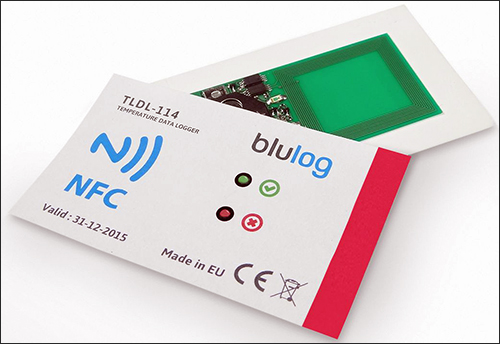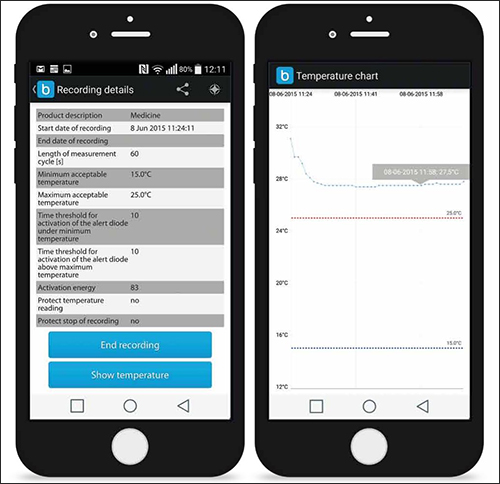Several European food and pharmaceutical companies are piloting a Near Field Communication (NFC)-based temperature datalogger from Polish-French startup Blulog that allows employees and clients to access temperature histories of products in the cold supply chain, via their Android smartphones. The Blulog solution features a battery-powered temperature datalogger that can be placed in the back of a truck, in a container or in a carton. When products reach their destination, a company can use an NFC-enabled Android smartphone with Blulog’s Blutag app to download and interpret the sensor’s temperature history. Blulog also offers an NFC RFID reader for those without Android NFC-enabled phones.
In May of this year, Blulog first sent out samples of its NFC dataloggers to approximately 50 European companies in the pharmaceutical, food and logistics markets. The technology is currently being tested by Eurocash, a national food retail chain in Poland, as well as by an ice cream manufacturer.

Blulog was founded by four engineers who had a variety of technology backgrounds but were all interested in making sensor-based data easy to collect via a mobile phone. The group saw a large need for wireless temperature-tracking solutions that were low-cost and easy to install, says Jérémy Laurens, the company’s sales and marketing director. Many traditional dataloggers require a computer and a USB connection to extract a PDF report regarding temperatures captured. What’s more, most passive RFID tags tend to have limited memory capacity, and active RFID-based systems offering real-time alerts and automatic uploads to the cloud can be expensive and cumbersome to install.
In addition, passive ultrahigh-frequency (UHF) RFID technology requires a handheld reader to capture data. The problem with that option, Laurens says, is that temperature-sensitive products, such as fresh produce and pharmaceuticals, are shipped across the world, often with multiple parties having ownership of those shipments at some point, and dispersing readers to all parties involved is not realistic. On the other hand, he notes, most people have an Android-based NFC-enabled smartphone in their pocket.
Over the course of several years, the firm developed a solution consisting of a single-use or reusable tag with sufficient memory to store up to 48,000 measurements. Since the solution utilizes an NFC-enabled phone, the app can also collect geolocation data at the time of the read, and automatically upload that information via the phone’s cell connection. The company built a prototype and, last year, began offering the product for piloting purposes. The NFC-based datalogger is now commercially available worldwide, as is the Blutag app, which can be downloaded at the Google Play website.
“NFC is still quite new for people, but they’re starting to get familiar with it,” Laurens states. “The advantage of NFC is that you can have a very small [temperature-logging] device that uses almost no battery [power].”
The NFC temperature logger, which measures 2.5 millimeters (0.1 inch) in thickness and has the same length and width as a credit card, uses the power of its built-in battery to measure temperatures ranging from -30 degrees to +70 degrees Celsius (-22 degrees to +158 degrees Fahrenheit), and to then store that data. The temperature-measurement rate can be selected through the Blutag app and sent to the datalogger via an NFC transmission. Blulog can also preprogram the device for the user prior to shipping it to that customer.
The datalogger illuminates a green indicator light if the device is working well and has not detected temperatures deviating from the desired range (as configured by the user). It flashes a red light in the event of a problem, such as the device’s battery running low or the temperature range having been exceeded. The datalogger’s battery, which is non-replaceable, has a lifespan of 36 days to one year, depending on which version of the datalogger the user has. The largest draw on the battery, however, is the illumination of the indicator lights, Laurens says. If its battery dies, the datalogger will no longer perform temperature measurements, but the temperature history data already stored in its memory can still be accessed via an NFC-enabled phone running the Blutag app.
Once the datalogger has been programmed and is ready for use, the user presses a button on the device to start the temperature-tracking process. Users can also utilize the app to encode the NFC datalogger’s memory with any logistics information, such as a tracking number, a product name or temperature requirements. The device can then be placed in the area at which temperatures will be monitored, such as in the back of a truck.

Once the shipment reaches its destination, such as a distribution center or store, employees at that location can then use the Blutag app on an NFC-enabled phone to download the temperature history. In that way, they can learn what the conditions have been for the product since it left the originating facility. That information—along with the location of the read event, based on the phone’s built-in GPS technology—can then be stored on a cloud-based server hosted by Blutag at no additional charge.
Users have the choice of sharing that data with others (via e-mail, Dropbox or a cloud-based server) or simply storing it for their own records. Access to the cloud-based data is free.
The NFC datalogger’s cost starts at €8 ($9) apiece for the single-use 36-day version. Blulog plans to offer a UHF RFID model that will cost about €20 ($23) apiece for the single-use 36-day version and enable real-time monitoring during transport, provided that a Blulog UHF GPRS hub, which contains an RFID reader, is installed in the vehicle used to transport the goods being shipped. The UHF datalogger contains a battery-powered UHF tag with a read range of up to 700 meters (2,300 feet), as well as a passive NFC RFID interface that enables a user to download the temperature history via a smartphone running the Blutag app. The UHF tag employs a proprietary air-interface protocol, so users would need to buy a Blulog UHF GPRS hub handheld device (manufactured at a partner facility in Poland), at a cost of €100 ($114) apiece. The hub’s long read range, Laurens says, makes it possible for users to capture temperature data even without opening a container. The UHF datalogger’s battery has an expected lifetime of 36 days to one year.
The Blulog UHF GPRS hub reader can be mounted in a truck and use the vehicle’s power source or its own internal battery for several days. It includes GPS location data based on its built-in GPS system, uses a GPRS connection to send real-time data to the back-end server hosted by Blulog. The device costs about €100 ($114).


